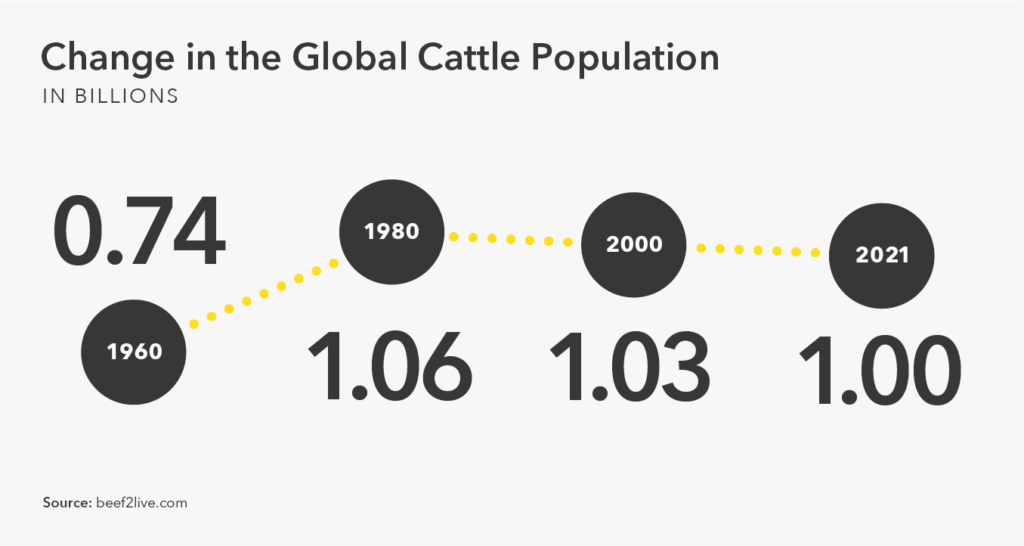News & Trends
The End of Cattle

Scientists Replace Butchers
Oat drinks from Oatly, planted chicken from Planted Foods or burgers from Beyond Meat are signs of an emerging boost in innovation in food production. Purely plant-based alternatives and new technologies could soon replace the conventional, resource-intensive production of meat and milk. Turning old into new – just differently.
BBy 2030, the number of cattle in the USA will decrease by 50 percent. Production volumes of the US beef and dairy industry and suppliers will decline by almost 90 percent by 2035. Manufacturers of fertilisers, pesticides or agricultural machinery will also feel these effects. It is not too much of a gamble to predict the bankruptcy of the cattle breeding industry. The geographical competitive advantage is then also passé: major exporters of animal products, such as the USA, Brazil or Australia, will lose their geopolitical influence on countries that are currently dependent on importing these products.
By 2035, 60 percent of the land currently used for livestock and animal feed production in the USA will be available for new ventures. If these areas were dedicated to reforestation or regenerating soils and plants, all the US’ current greenhouse gas emissions could be fully offset by 2035. A scenario from the category “It could be so simple”.
The triumph of plant proteins – not a question of “if”, but “how fast”.
Molecular Cuisine Meets the Old World
Futurologists at RethinkX think tank are making these predictions. But why? They see rapid progress and price reductions in “precision fermentation” as the main drivers. Microorganisms are genetically programmed to produce almost any complex organic molecule. So we are not talking about “lab meat”, but targeted fermentation, as is already used to produce ingredients or enzymes for insulin, cheese production, sweeteners, flavours and vitamins.
The controversial industrialised system of animal husbandry could be replaced by a “food-as-software” model. Scientists develop foods at molecular level and make them available in databases – accessible to food designers all over the world.
Is the RethinkX study simply wishful thinking by technology disciples? Or is there really some meat on the bone? Not surprisingly, representatives of the meat and dairy industry speak of a “vegan fantasy land”. For them, a lot is at stake: tied-up capital, business models, jobs. But this very power of the status quo has already been overestimated in past disruptions. If online trade, travel platforms, accommodation agencies or transport services have taught us anything, it is the power of objective superiority in price and quality.

Not If, But When
Food disruption will happen in stages. Products with simple cell structures are being replaced first – mince before steak, so to speak. Likewise, products such as milk with a low concentration of valuable nutrients as well as substances rarely found in nature will have a particularly hard time.
The triumph of plant proteins depends less on whether disruption occurs, but how fast. Looking at the official projections on nutrition, it quickly becomes clear: the current system leads to a dead end. According to UN forecasts, almost ten billion people will need to be fed in 2050. Total demand for resource-intensive foods would also likely increase by 70 percent due to higher incomes. It is hard to imagine how this increasing demand is to be met in an era of climate stabilisation, resource conservation and eradicating poverty!

Acquiring a Taste for It
Even the influential “Sustainable Food Future” report by the World Resources Institute sees technological innovations as elementary pillars of a global strategy, alongside increased productivity, waste prevention, a reduction in meat consumption and reforestation.
The objective superiority of plantbased technologies becomes clear. If the cultural aspects of food, such as taste and aesthetics, as well as the price are right, we consumers are quite prepared to accept innovations quickly. Best example: oat drinks, meat alternatives and the like are already flooding the food shelves.










